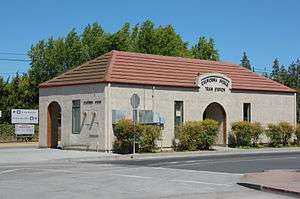California Avenue station
| Commuter rail | ||||||||||||||||||||||
 Station building | ||||||||||||||||||||||
| Location |
101 California Avenue Palo Alto, California, United States | |||||||||||||||||||||
| Coordinates | 37°25′44″N 122°08′29″W / 37.42889°N 122.14139°WCoordinates: 37°25′44″N 122°08′29″W / 37.42889°N 122.14139°W | |||||||||||||||||||||
| Owned by | Peninsula Corridor Joint Powers Board | |||||||||||||||||||||
| Line(s) | ||||||||||||||||||||||
| Platforms | 2 side platforms | |||||||||||||||||||||
| Tracks | 2 | |||||||||||||||||||||
| Connections |
| |||||||||||||||||||||
| Other information | ||||||||||||||||||||||
| Fare zone | Fare Zone 3 | |||||||||||||||||||||
| History | ||||||||||||||||||||||
| Rebuilt | 1984 | |||||||||||||||||||||
| Traffic | ||||||||||||||||||||||
| Passengers (2017) |
1668 per weekday[1] | |||||||||||||||||||||
| Services | ||||||||||||||||||||||
| ||||||||||||||||||||||
California Avenue is a Caltrain station near milepost 31.7 in Palo Alto, California. It stops at the historical town center of Mayfield, which was annexed by the town of Palo Alto in 1925. The current station structure was built in 1983 and the station was expanded from one platform to two in 2008.
Platforms and tracks
| Northbound | ■ Local service | toward San Francisco (Stanford or Palo Alto) |
| ■ Limited-stop service | toward San Francisco (Palo Alto) | |
| ■ Baby Bullet | No stops | |
| Southbound | ■ Local service | toward Gilroy (San Antonio) |
| ■ Limited-stop service | toward Tamien, Gilroy during peak hours (San Antonio) | |
| ■ Baby Bullet | toward Tamien (Sunnyvale) |
History
Rail service to Mayfield from San Francisco began in 1863; until January 1864 passengers had to transfer to a stagecoach to continue to San Jose.[2] The first station was approximately half a mile northwest of the current site; it was relocated two years later after residents complained the location was inconvenient and William Paul, a storekeeper and benefactor of the town, donated land on what was then Lincoln Street. The station built in 1869 was replaced in 1955, and again in 1983 in conjunction with the development of the nearby Palo Alto Central condominium complex.[3] After Palo Alto annexed Mayfield in 1925, Lincoln Street was renamed to California Avenue because Palo Alto already had a Lincoln Street;[4] the station took that name in 1941.
Until 2008 the station had a central boarding platform and could only accommodate one train at a time, necessitating a hold-out rule. That year the station was reconfigured to have two outside platforms and a pedestrian underpass replaced the former at-grade crossing, eliminating the need for the hold-out rule.[5][6] A fence between the tracks helps keep passengers off the tracks. A ticket vending machine is located at the entrance to the pedestrian underpass so that people can buy or validate their tickets before going to the northbound platform.[5] New shelters for passengers needing assistance are located at the northern end of the platforms, next to the manual wheelchair lifts. The shelters have been modified to accommodate wheelchairs.
Service and ridership
The California Avenue station is ranked 12th in weekday riders as of 2015 based on the 2015 Caltrain Ridership Counts Publication.[7] Ridership has been recorded at an average of 1,553 weekday riders, or 2.67% of total weekday riders for the line (this is an increase since 2011 when it was 895 weekday riders). The station is served by few trains compared to stations of similar ridership levels. Starting April 2017, it will be served by Baby Bullet Express trains in the evening peak.
References
- ↑ Caltrain. "2017 Annual Count Key Findings Report" (PDF). Retrieved 2018-01-29.
- ↑ "Early Milestones". Caltrain. Retrieved 2018-08-02.
- ↑ Ward Winslow, ed. (1993). Palo Alto: A Centennial History. Palo Alto, California: Palo Alto Historical Association. pp. 26, 150. ISBN 9780963809834.
- ↑ Winslow, p. 33.
- 1 2 "Caltrain to Open New Boarding Platform at California Avenue Station". Caltrain News. Caltrain. November 19, 2008. Archived from the original on December 6, 2008.
- ↑ Don Kazak (November 24, 2008). "Caltrain opens new California Avenue platform". Palo Alto Weekly.
- ↑ Caltrain. "February 2015 Caltrain Annual Passenger Counts" (PDF). Retrieved 2014-07-11. The survey takes place in February of each year.
External links

- Caltrain California Ave. station page
